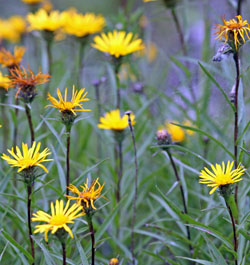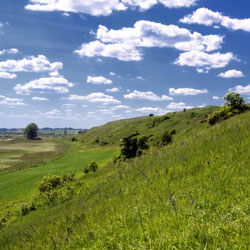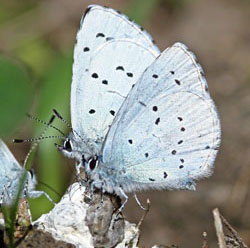
|
DOBUŻEK (PLH060039)
Ostoja Dobużek PLH060039 of 199.3 ha in size was established to protect part of the Huczwa River valley with humid meadows and xerothermic grasslands growing on its steep, southern exposed slopes about 1 km. northwest of the village of Dobużek. This area is in the Zachodniowołyńska Upland in the Grzędy Sokalska meso-region. It lies entirely within the administrative boundaries of Tomaszów Lubelski County (Tyszowce Township). The great value of the thermophilous plant assemblages here was already recognized in the 1950s, but it wasn't until 1989 that the 5.07 ha "Skarpa Dobużanska" nature reserve was created. It is currently entirely within the boundaries of a Natura 2000 site.
Among the habitats found here under special legal protection in the European Union, the most valuable are the assemblages of xerothermic grasslands (code 6210) growing on the partially eroded slopes that have great value for the landscape. Seven plant species under protection in Poland grow here. One can find Achillea setacea here, growing in only two sites in the region. Great masses of Aster amellus grow here, as well as other commonly found species typical of xerothermic grasslands, including: Anthericum ramosum, Verbascum phoeniceum, Salvia pratensis, Prunella grandiflora and others.
The fauna at this site was studied in the 1970s and 1980s, when Mustela eversmanii and Spermophilus suslicus were observed. Spermophilus suslicus had a small colony here then, which has not been able to be confirmed since despite searches. Mustela eversmanii probably no longer exists in Poland. Among the invertebrates, Papilio machaon can be seen here, as well as some of the more common species, such as Vanessa cardui and Plebeius argyrognomon.
The area of the reserve was formerly used as agricultural fields. The fallow fields were quickly taken over by xerothermic vegetation. After the reserve was created, grazing was abandoned, resulting in the overgrowth of ground covers and blackthorn. This caused several previously present species requiring unobstructed sunlight to die out, such as Iris aphylla, and among the animals, Spermophilus suslicus, whose occurrence is strictly connected to the presence of grazed pastures.
     
|

|



|








